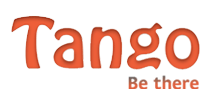Video chat service Tango is moving in a new direction, and this week the company closed a round of $40 million in Series C funding which will take it there, it hopes. Many think of Tango’s service as an up-and-coming Skype competitor, as it, too, is about real-time communication, specifically video calling, between users. But the comparison to Skype may no longer be apt. Tango is working towards becoming a more social service – something more akin to the micro social network Path, in fact.
On the roadmap are several new social features, some of which make sense for a phone replacement utility (like text messaging), others which seem more like a shift to a social network (like exchanging photos).
Tango’s co-founder Eric Setton describes his vision for Tango’s future not as a video chat service, or even a communications service, but as “a service that keeps you closer to those you care about.”
Getting there has been all about taking baby steps, Setton explains. “We’re very cautious in everything we introduce,” he says. “We first want to check with the market that everything we’re thinking isn’t just our imagination,” he says. Features don’t roll out fully baked, but are introduced, tweaked, and then expanded upon.
 Case in point: the slow way that Tango has rolled out video messaging. This newer feature, which allows users to leave video messages for others, was originally introduced in December as a kind of “video voicemail” option. In January, responding to user feedback, Tango allowed users to send these messages without having to first dial the recipient’s phone. This week, the company rolled out support for one-to-many video messaging, perfect for sharing things like baby’s first steps with the entire family. Soon, Tango will add video message replies, too.
Case in point: the slow way that Tango has rolled out video messaging. This newer feature, which allows users to leave video messages for others, was originally introduced in December as a kind of “video voicemail” option. In January, responding to user feedback, Tango allowed users to send these messages without having to first dial the recipient’s phone. This week, the company rolled out support for one-to-many video messaging, perfect for sharing things like baby’s first steps with the entire family. Soon, Tango will add video message replies, too.
If the latter additions make you think that Tango is beginning to feel a little bit more like a social network than a utility, you would be right. Setton says the company has been asking itself, “what do we want to be when we grow up?”
“We’ve clarified that a lot over the last six months,” he says, “and here’s what we see it as: because of the nature of video calls, which is so much more personal and intimate, we’re addressing a small audience around you – your spouse, your kids, your parents, your really close friends – what Path calls the ‘intimate social network’….we, by default, play within that circle.”
And in this more intimate network – the ones you’ve deemed “favorites” within Tango’s app, for example – it’s about sharing, not just phoning.
“When you think about these people [in your personal network], what do you do with them? These are the people that you call with your normal phone, these are the people that you text, these are the people that you exchange pictures or videos with, these are the people that you actually want to celebrate occasions with, etc…so rather than thinking about us as a phone replacement, it’s really about bringing all these interactions to the service,” says Setton.
 Tango is now working on the video messaging component, and the infrastructure needed to store your saved video messages in the cloud so your messages are still available as you move from phone to phone. It also recently introduced animations (Tango Surprises), which you can add to messages to give them a little flair.
Tango is now working on the video messaging component, and the infrastructure needed to store your saved video messages in the cloud so your messages are still available as you move from phone to phone. It also recently introduced animations (Tango Surprises), which you can add to messages to give them a little flair.
Although Tango is free, it’s starting to monetize through in-app purchases for things like more storage space for messages or different animations.
As for the future, text messaging and photo-sharing are on the way. What about status updates and checkins, we asked? “We can’t share the whole roadmap,” Setton hedged. But in terms of what social features he didn’t think would be a good fit going forward, he only said that public sharing wasn’t something under consideration.
“Tango is not really about blasting,” Setton explains, referring to networks like Socialcam which are meant for sharing video to a larger audience on social networks. “The ‘following’ model – that’s not really us,” he says.
The obvious comparison, then, if Tango is going the social networking route, is with Path, also deemed an intimate network of your closest friends and family. But while Tango is clearly moving into Path territory, it’s doing it its own way.
“We come from the communication angle – that’s been a very strong driver for growth – we don’t really approach it from the same angle…real-time communications will always be an integral part of the things that we do,” says Setton. “Also,” he adds with a grin, “I don’t see you stopping using the phone anytime soon.”
The real-time communications angle has, indeed, proven to be successful so far for Tango’s growth. The number of daily calls has doubled in the past four months, and the number of daily registrations have doubled since July.
There are now over 45 million people on Tango, 10% of whom use it daily, and 44% of which are active users.
The service’s $40 million C round, announced earlier this week, brings in new investors Qualcomm Incorporated, acting though its venture arm, Qualcomm Ventures, and Access Industries, Inc., the industrial holding company founded by Len Blavatnik. It also sees additional investment from members of Eric Setton’s family, who have been early supporters. Other investors include Draper Fisher Jurvetson, Michael Birch, Andy Bechtolsheim, and Bill Hambrecht. Tango now has $87 million in total funding to execute its vision.
Tango is available on Android, iOS, Windows Phone, and Windows desktop and is working to bring a native iPad app out in the near future. Setton wouldn’t comment on the company’s Mac plans, however, but hopefully it, too, will arrive soon.
